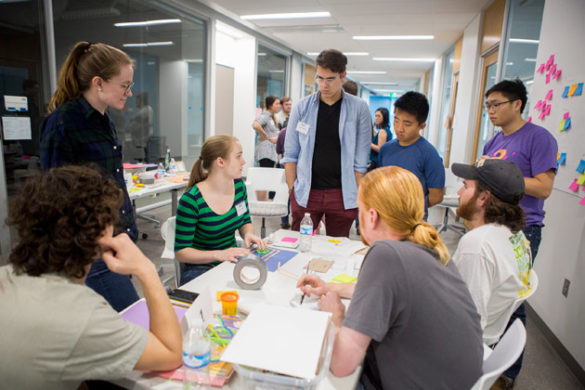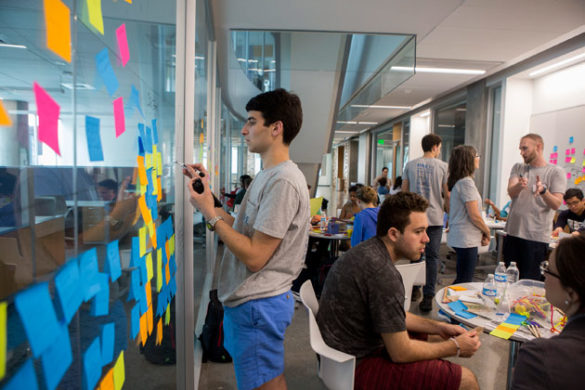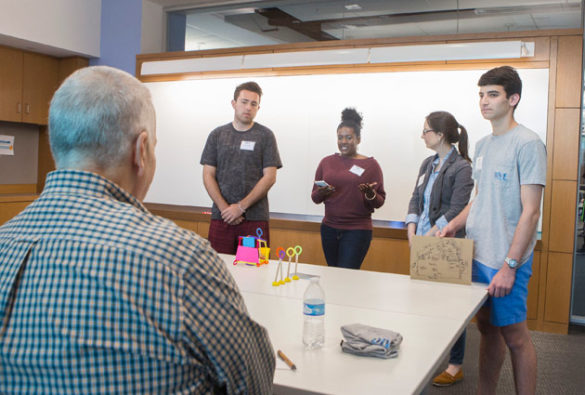
More than 40 students, staff and faculty gathered at the Wond’ry March 25 to learn about human-centered design and put it into practice through a series of exercises. The half-day event was the inaugural DIVE Boot Camp, one of several opportunities for members of the Vanderbilt community to participate in Design as an Immersive Vanderbilt Experience (DIVE), the university’s Quality Enhancement Plan.
“I’m hearing a lot of positive feedback,” said Will Berger, a sophomore engineering science major who worked with the Office of the Provost to develop the DIVE initiative. “There are a lot of people here who I’ve never met before, which shows we’re having a broad impact on campus. It seems like everyone’s really eager to participate.”
DIVE is a new program that aims to promote human-centered design thinking among Vanderbilt students, faculty and staff to solve real-world problems and develop critical thinking skills.
“Design is in everything,” Berger noted. “It’s in the products we buy, but it’s also in the marketing of those products. It’s in the processes we use everyday, from the experience we have buying groceries to the way we withdraw money from the ATM.” Design thinking has been applied to almost every discipline, he said, from government to banking to law.

The Boot Camp participants were given a primer on the five steps of human-centered design—empathize, define, ideate, prototype and test—then tasked with using those steps in two challenges.
The first challenge had participants partner in teams of two to “redesign the gift-giving experience.” The exercise emphasized communication with each other to build empathy, a hallmark of human-centered design. The second challenge required teams of four to travel to Rand Hall to interview users of the dining facilities in an exercise to “redesign the Vanderbilt dining experience.” The participants then returned to the Wond’ry to define the problem, brainstorm, make rough prototypes and test their solutions before presenting them to administrators from Campus Dining.
“The great thing about human-centered design is that it’s transferable to a lot of different types of problems,” said Lori Troxel, director of the DIVE initiative and associate professor of the practice of civil and environmental engineering. “Today we’re looking at Rand dining, but the participants could take the same process and apply it to their fraternity or sorority, their major, group projects and more.” Troxel is teaching human-centered design as a component of her Sustainable Development class this spring, resulting in better, more robust projects from her students, she said.

During the “ideate” portion of the Rand dining challenge, a diverse group of bootcampers arranged and rearranged brightly colored Post-it notes on a glass wall near their Wond’ry workspace, animatedly conferring with one another. The group included Christina Pagano, a freshman who plans to major in economics and history; Harrison Vandervort, a sophomore mechanical engineering major; Maria Servodidio, a senior vocal performance major; and Mia Shang, an Owen Graduate School of Management student.
“I wanted to do the DIVE Boot Camp to gain some experience with the design process and to interact with people from other parts of campus,” Vandervort said. “A big part of engineering is communicating, and communicating effectively. I think DIVE is a great way to gain the skills to do that.”
“The Boot Camp is a good experience because it’s short—it’s a one-day experience. We went through the whole process from user experience to coming up with a prototype and presenting it to the end user,” Shang said.
Victoria Morgan, a researcher in radiology and biomedical engineering, said she attended the Boot Camp because she’s interested in applying human-centered design to a new School of Medicine program called MIDP—the Medical Innovators Development Program—geared toward engineers and Ph.D.s.
“The idea is to combine engineering skills and medical skills to design medical devices, global health programs—that sort of thing,” Morgan explained. “We have two students here today who are in our program, and I wanted to attend the Boot Camp as well since I am leading the students. It’s been great so far.”

The next DIVE Boot Camp is planned for August at the start of the fall 2017 semester. But Boot Camps are just one way to get involved in the DIVE initiative. Other “Deep DIVE” experiences include DIVE Co-Curricular Projects, DIVE Enhancing Existing Courses and a DIVE University Course called Design Thinking, Design Doing taught by the Owen School’s David Owens and Peabody College’s Rogers Hall.
To learn more about Design as an Immersive Vanderbilt Experience, visit the DIVE website.